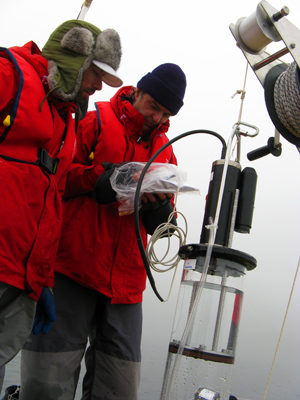The role of LOOP in REPLIM
One of the main objectives of REPLIM is to establish a network of monitoring sites in lakes and peatbogs across the Pyrenees, in order to observe the effects of global climate and environmental change on these sensitive ecosystems. The main tasks of LOOP in the project are related to the development of new methods and protocols adapted to the requirements of long term monitoring in high elevation lakes.
In particular, we will define and undertake the first stages of the design of a robotic system for measuring a wide range of physico-chemical parameters in the water column of the lakes in real time, and we will develop molecular techniques for monitoring the plankton of the lakes. Once these new monitoring tools are set up, they could potentially be extended to the whole observation network.
A robot for monitoring remote lakes 
High mountain emplacements are relatively remote sites with a difficult access. For this reason, it is necessary to have automatic systems for data collection, like automatic weather stations for instance. But while these are already available in the market for remote applications, comparable systems able to collect limnological data are scarce, and are limited to a small number of basic parameters. We aim to develop a system to meet the need of such autonomous measuring devices for long term, yet also high-frequency, monitoring of remote lakes. We aim to a first design stage ("concept formulation") of a robot able to take water samples from different depths and to analise in real-time a suite of physico-chemical variables. This robot should be connected via the Internet (using either terrestrial or satellite networks) to its base, for downloading data, changing the programming of the system, or even conducting non-programmed tasks by remote control by an operator. The basic parts of the envisaged system are: 1) solar power supply; 2) physical parameters measurement (water temperature, light extintion, incoming radiation, wind speed and direction, air temperature and humidity); 3) water samples extraction and filtration; 4) chemical analysis units, based on specific sensors (electrical conductivity, pH, redox, ammonium, major cations, chloride, dissolved oxygen and CO2), UV and VIS spectrophotometry (direct measurements for coloured dissolved organic matter and nitrate, and colourimetry for nitrite, sulphate, phosphate and silicate), and fluorometry (chlorophyll a, fluorescent dissolved organic matter); 5) control and communications system, operated by onboard computers.
 Monitoring the response of plankton to Global Change using molecular techniques
Monitoring the response of plankton to Global Change using molecular techniques
In recent times, big progress has been done in the use of DNA-based, molecular techniques for the characterisation of the microbial world of plankton. Such techniques have been (and still are) extensively used as the only tool to differenciate the composition of prokaryotes communities. Yet, there are less applications to the protists communities. For this, it is necessary to check the molecular results against the morphologic classification based on observations under the microscope. In this project, we will compare the morphologic diversity of plankton with the genetic diversity obtained from sequencing the 18s gen. The characterisation of the morphologic diversity requires very specialised taxonomic skills, which are not always achievable in monitoring programs. Through the comparison of both methods, we aim to assess the potential usefulness of molecular techniques to monitor protists in plankton from high mountain lakes as an alternative to microscope identification. The first task will be the examination of samples taken from the water column of the lake every second month, over a full seasonal cycle. A second step will be to compare the communities found in the water column with the the remains contemporary collected in sediment traps. The recently formed sediment collected in the traps contains biological material, including senescent cells and resting stages (such as chrysophycean cysts) that cannot be identified visually, but can be determined using DNA sequencing. The molecular analysis of the material collected in the traps can thus be used to analyze the composition of communities leaving a footprint in the sediments, as well as to integrate the planktonic biodiversity over time.
